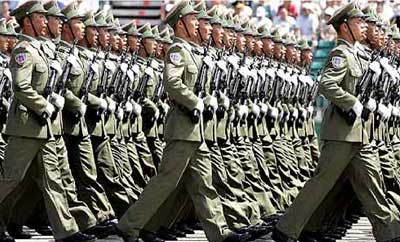 This article was originally published in Manufacturing & Technology News on August 30th, 2010.
This article was originally published in Manufacturing & Technology News on August 30th, 2010.
Military Begins To Contemplate The Impact Of America’s Deindustrialization
By Richard McCormack
 The military uses of nanotechnology are just
The military uses of nanotechnology are just
part of China’s massive program of research and development.
(Credit Photo: AFP/Getty Images as published in the Guardian, March 2009 )
09/30/2010 – The U.S. military is starting to consider how China’s economic growth and the corresponding loss of important American high-tech industries might impact future national security. The Project on National Security Reform run by U.S. Army War College’s Strategic Studies Institute, an independent academic group, has put together a “Vision Working Group” that is assessing various future possible military scenarios including how to deal with a more aggressive China if the United States does not have much left of an industrial base.
“Weaknesses in our defense industrial base supply chain, dependency on third-party vendors, continual disregard for the Berry Amendment, and lack of foresight regarding the interplay between the global economy and national security are the root causes” of a potential U.S. “failure,” according to the assessment, which notes that its views do not reflect the official policy or position of the U.S. government, the Army or the Department of Defense.
The U.S. government does not do an adequate job of assessing the national security implications of China’s rise, notes the Strategic Studies Institute in its “Vision Working Group Report and Scenarios.” “Nowhere in the U.S. government will one find personnel dedicated exclusively to developing overarching strategy with a long-term view. It is imperative to remedy this deficiency in order to avoid disastrous consequences, and reduce risks — both potential and real.”
It is not hard to imagine China exerting its increasingly high-tech and capable military muscle against the United States. Such a scenario “is not a product of fantasy or prediction, but rather of practical reasoning and logical deduction,” says the Vision Working Group’s report. “To be sure, the framework required for disaster [if] this scenario [is] to unfold is largely already set.”
The Chinese have already “infiltrated” much of the U.S. industrial base by targeting automotive, aerospace, metals and electronics, according to the assessment. The U.S. military has further enabled China by insisting on purchasing “off the shelf ” commercial technologies that are now made in China, and through the near elimination of MILSPEC requirements. “These changes have caused some concerned individuals within industry, government and the Pentagon to derisively call the changing state of affairs in terms of weapons systems development and procurement, along with acquisition support materiel, ‘the Wal-Mart Military,’ ” according to the vision report. “Economy and competitiveness, not security and performance, are the overarching parameters of DOD supplier participation.”
National security vulnerabilities “are literally being built into our offensive, defensive, and detection systems,” says the study. “A veritable Pandora’s box of systems security compromises was thrust open due to a gradual reduction in standards and shortsightedness by too many within industry and government. . . It is only a matter of when — not if — disaster will occur.”
The Chinese are actively engaged in acquiring the most advanced military technologies through commercial operations in the United States, and the lack of U.S. federal government oversight of Chinese business acquisitions. “We know from interactions with Chinese representatives, industry spokesmen, and government and military personnel that specific strategies are in place to gain control of various elements of the U.S. industrial and defense industrial bases,” says the study. The Chinese are purchasing high-tech U.S. suppliers that are under financial stress. They are also providing financial assistance to U.S. companies that are in need of cash “until they work their problems out,” according to the Vision Working Group. Such partnerships provide the Chinese with cover from charges of industrial espionage and copyright laws.
The Chinese are able to gain access to important technologies…..U.S. defense contractors have no transparency within their supply chains, the study notes. The Pentagon does not know which components in military systems are made overseas.
Furthermore, the Chinese control of global shipping puts the United States in a dependent and precarious position, with the potential for “economic chaos in the United States and its surge capability,” which could “disappear.” The United States, says the vision document, “needs a plan to ‘win’ the war, economically, diplomatically, politically and militarily with China and other emerging powers.”
The Vision Working Group recommends the creation of a new Center for Strategic Analysis and Assessment that would reside within the Executive Office of the President. “Fragments of such a system exist in various parts of the federal government,” writes Leon Fuerth, from the Project on Forward Engagement.
“But no single system exists for the application of foresight to governance as a whole.” The center would provide policymakers with “foresight and awareness of the path we are on, of the consequences of our decisions and of the major challenges that await us. Doing this involves, in part, the continuous development and exploration of future scenarios to enhance our preparedness and improve our chances of success…. If this goal is to be achieved, the United States will move from merely reacting to emergencies to pre-empting them, from responding to threats to seizing opportunities. . . Failure to act could mean that the nation is caught off guard by emerging threats, unable to see them until they have become imminent and, perhaps, intractable problems. In the worst case, the country could suffer what has been described as a synchronous failure, wherein the adaptive capacity of government and society is overwhelmed by the convergence of diverse and interacting stresses, resulting in a breakdown of institutional and social order.”


